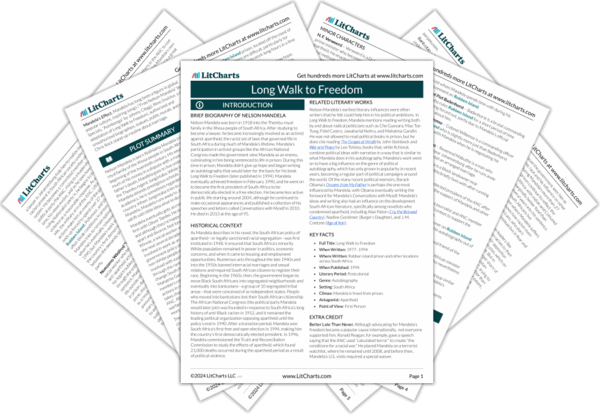The prison on Robben Island symbolizes the South African government’s goals with apartheid: to isolate Black South Africans, sow division, and in doing so, deprive them of any power and agency. Robben Island is the first of the three prisons where Mandela serves his over-27-year sentence. The island is physically cut off from the rest of the country by water, showing how Mandela’s imprisonment is an attempt not just to punish him but to remove him from the nation’s political scene. Within the prison, the authorities go even further to isolate Mandela, limiting the times when he can talk to his fellow prisoners and transferring him once he gets too influential among one group of prisoners.
What the prison authorities do to Mandela and other Black prisoners is similar to what South African authorities are doing to the country in general under apartheid, with life in the prison often being a microcosm for life in South Africa at large. For example, just as they receive slightly preferential treatment outside the prisons, Indian and Coloured prisoners have slightly better diets than Black prisoners, and they’re also allowed to wear long trousers. The Robben Island prison thus symbolizes the cruel tactics that the South African government used to isolate activists like Mandela and attempt to sow division among them—but it also ends up highlighting the strength of Mandela’s character, and his firm belief that apartheid will only end if people can come together and work toward a common goal.
Robben Island Quotes in Long Walk to Freedom
That first week we began the work that would occupy us for the next few months. Each morning, a load of stones about the size of volleyballs was dumped by the entrance to the courtyard. Using wheelbarrows, we moved the stones to the center of the yard. We were given either four-pound hammers or fourteen-pound hammers for the larger stones. Our job was to crush the stones into gravel.
In jail, all prisoners are classified by the authorities as one of four categories: A, B, C, or D. A is the highest classification and confers the most privileges; D is the lowest and confers the least. All political prisoners, or what the authorities called “security prisoners,” were automatically classified as D on admission. The privileges affected by these classifications included visits and letters, studies, and the opportunity to buy groceries and incidentals—all of which are the lifeblood of any prisoner. It normally took years for a political prisoner to raise his status from D to C.
For me, hunger strikes were altogether too passive. We who were already suffering were threatening our health, even courting death. I have always favored a more active, militant style of protest such as work strikes, go-slow strikes, or refusing to clean up; actions that punished the authorities, not ourselves. They wanted gravel and we produced no gravel. They wanted the prison yard clean and it was untidy. This kind of behavior distressed and exasperated them, whereas I think they secretly enjoyed watching us go hungry.
The High Organ was the source of some controversy because of its ethnic composition: all four permanent members were from Xhosa backgrounds. This was a matter of coincidence rather than design; the senior ANC leadership on the island, the only four to have served on the National Executive Committee, happened to be Xhosa. It would not have been proper to take a less senior comrade and put him on the High Organ simply because he was not a Xhosa. But the fact that the High Organ was Xhosa-dominated disturbed me because it seemed to reinforce the mistaken perception that we were a Xhosa organization.
One day, Kathy, Walter, and myself were talking in the courtyard when they suggested that I ought to write my memoirs. Kathy noted that the perfect time for such a book to be published would be on my sixtieth birthday. Walter said that such a story, if told truly and fairly, would serve to remind people of what we had fought and were still fighting for. He added that it could become a source of inspiration for young freedom fighters. The idea appealed to me, and during a subsequent discussion, I agreed to go ahead.












